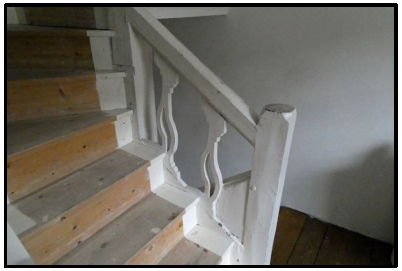As elsewhere on this website, we are grateful to local historian Alan H J Green for permission to reproduce this report of a visit he made to the property
“No 32 is one of several 17C timber-framed houses on the north side of Northgate, doubtless rebuilt soon after the sack of Westgate by William Waller’s troops in 1642. As with the others in this terrace it received a Georgian brick front in the 18C. It is abutted on the west by the former Waggon and Lamb public house and on the east by another (smaller) house. It was originally numbered 38 but at some time between 1939 and 1950, when Westgate was converted to ‘odds and evens’, it was renumbered 32. It is listed Grade II.
Exterior
It is a two-storey house with attic and of three bays, with the front door in Bay 3. The brick front has been stuccoed as has its neighbours. It is a double pile beneath a tiled ‘M’ roof whose ridge line is lower than the two abutting buildings. Indeed, the irregular roofline of the whole terrace strongly suggests that the post-1642 rebuilding had taken place in a piecemeal fashion. There is a central chimney stack adorned with some Fareham pots.
At the front there are two ‘S’ shaped pattress plates between the floors indicating that at some time the stability of the brick front has had to be addressed with tie bars. This is a common feature of re-fronted houses in Chichester – tying brickwork into a timber frame was not an exact science! The windows to the front have 6/6 sashes but are horned indicating that they are later replacements. The simple doorcase (which matches that on No 30) has a triangular pediment, and the six-panel front door has had its four upper panels glazed at some time.
At the rear, the three first floor 6/6 sash windows have characteristic early 18C thick glazing bars, but one window has recently been replaced, exactly like-for-like.
A rear single-storey outbuilding under a slate roof has now been annexed as an additional room for the house and a single-storey flat-roofed extension has recently been added to the rear of the main house, in the course of which the original ground-floor rear wall was removed.
Interior
Much pleasing interior detail has survived, including some three-panel doors with the centre panel lying (a popular design at the end of the 17C), hand-forged hinges of strap and H-L form and some plain dado panelling. There is no full-height panelling but during repairs to a partition wall a large piece of canvas (scrim) carrying around six layers of early wallpaper was rescued by the owner. The most striking internal feature is the dog-leg staircase which rises to the attic around a plain, square newel post. It is a fairly characteristic 17C staircase for a humble house with a typically chunky handrail supported by wide-spaced, pierced splat balusters, but these are of an unusual wavy form.

The topflight of the staircase from first floor to the attic shewing the winding treads to the turn and the unusual wavy form of the splat balusters. Out of sight beyond the turn, the handrail has been lowered at some time and the balusters removed. (Photo Alan Green)
The two ground-floor rooms have fireplaces in the central chimney stack and the current owner has removed several later insertions of chimneypieces and grates to reveal the extent of the original wide hearths. That to the rear (the original kitchen) has a heavy timber bressummer which has also been exposed and the hearth has been brought back into use.
Many of the internal beams had been boxed in in modern times but the current owner has been exposing them restoring much of the building’s character.”
Richard Brownfield adds: In the kitchen, previously an outhouse, a burnt rafter was found, possibly from the 1642 fire. When restoring the fireplace in the sitting room, 5 fireplaces from successive dates were found but removed.